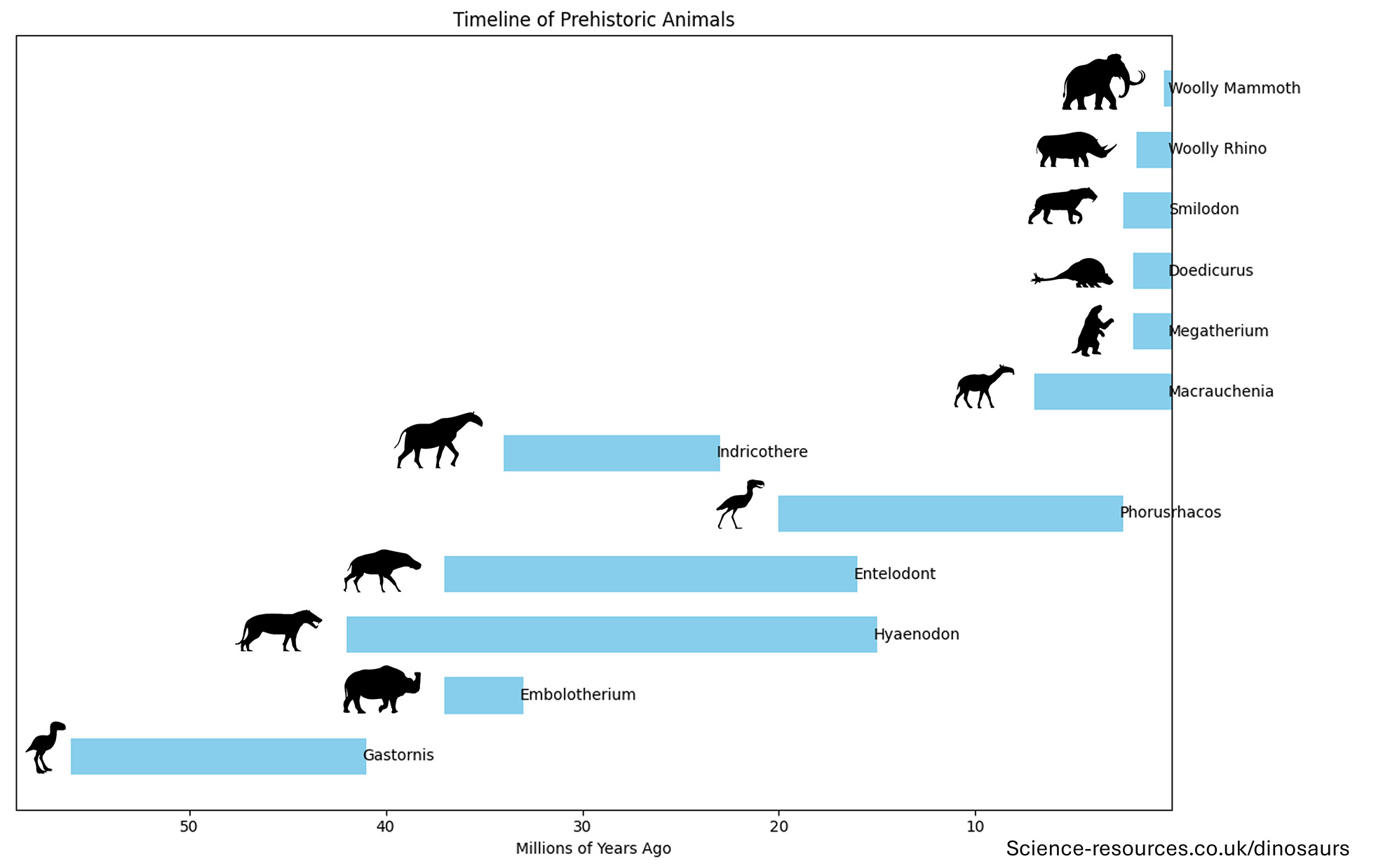Last updated: 4th August 2025
Extinct Animals by Geological Period
When they lived
The distribution of ancient animals across the globe provides critical clues about plate tectonics, climate change, and migration patterns. This section organises our featured animals by the continents where their most significant fossil remains have been discovered. This helps to paint a picture of how different parts of the world supported unique megafauna during prehistoric times.
Select a continent from the list below to discover the fascinating animals that once lived there.
Geological Periods
 Timeline of Prehistoric Animals
Timeline of Prehistoric Animals
Eocene Epoch
The Eocene epoch, spanning from approximately 56 to 33.9 million years ago, was a time of immense warmth and tropical climates. This period saw the diversification of early mammals, with the ancestors of modern horses, whales, and primates beginning to appear. The continents were still in motion, and large, lush forests dominated the landscape.
Miocene Epoch
The Miocene, from 23 to 5.3 million years ago, marked a significant global cooling trend. This led to the expansion of grasslands and the decline of forests. The epoch is often referred to as the 'golden age' of mammals, with large herds of grazing animals and powerful predators evolving to fill new ecological niches.
Pliocene Epoch
From 5.3 to 2.6 million years ago, the Pliocene epoch was a transitional period. The climate continued to cool, leading up to the Ice Age. The formation of the Isthmus of Panama connected North and South America, triggering a massive exchange of species known as the Great American Interchange.
Pleistocene Epoch
The Pleistocene, from 2.6 million to 11,700 years ago, is best known as the 'Ice Age.' This epoch was characterised by repeated glacial cycles, where vast ice sheets advanced and retreated across the globe. It was the age of megafauna, including the Woolly Mammoth and the Saber-toothed Cat, and also saw the evolution of modern humans.
You may also be intrested in:
- Extinct Animals: A-Z
- Dinosaurs: A-Z
Tags: Eocene epoch, Miocene epoch, Pliocene epoch, Pleistocene epoch, Cenozoic Era,
© 2012 science-resources.co.uk. All rights reserved | Design by W3layouts
Extinct Animals by Geological Period
When they lived
The distribution of ancient animals across the globe provides critical clues about plate tectonics, climate change, and migration patterns. This section organises our featured animals by the continents where their most significant fossil remains have been discovered. This helps to paint a picture of how different parts of the world supported unique megafauna during prehistoric times.
Select a continent from the list below to discover the fascinating animals that once lived there.
Geological Periods
 Timeline of Prehistoric Animals
Timeline of Prehistoric Animals
Eocene Epoch
The Eocene epoch, spanning from approximately 56 to 33.9 million years ago, was a time of immense warmth and tropical climates. This period saw the diversification of early mammals, with the ancestors of modern horses, whales, and primates beginning to appear. The continents were still in motion, and large, lush forests dominated the landscape.
Miocene Epoch
The Miocene, from 23 to 5.3 million years ago, marked a significant global cooling trend. This led to the expansion of grasslands and the decline of forests. The epoch is often referred to as the 'golden age' of mammals, with large herds of grazing animals and powerful predators evolving to fill new ecological niches.
Pliocene Epoch
From 5.3 to 2.6 million years ago, the Pliocene epoch was a transitional period. The climate continued to cool, leading up to the Ice Age. The formation of the Isthmus of Panama connected North and South America, triggering a massive exchange of species known as the Great American Interchange.
Pleistocene Epoch
The Pleistocene, from 2.6 million to 11,700 years ago, is best known as the 'Ice Age.' This epoch was characterised by repeated glacial cycles, where vast ice sheets advanced and retreated across the globe. It was the age of megafauna, including the Woolly Mammoth and the Saber-toothed Cat, and also saw the evolution of modern humans.
Tags: Eocene epoch, Miocene epoch, Pliocene epoch, Pleistocene epoch, Cenozoic Era,
© 2012 science-resources.co.uk. All rights reserved | Design by W3layouts